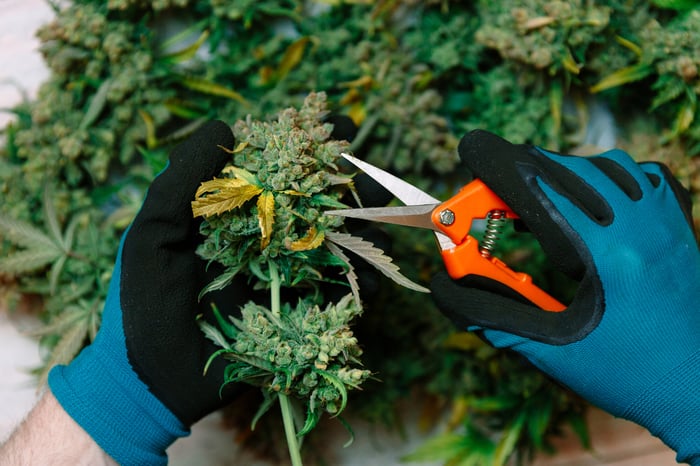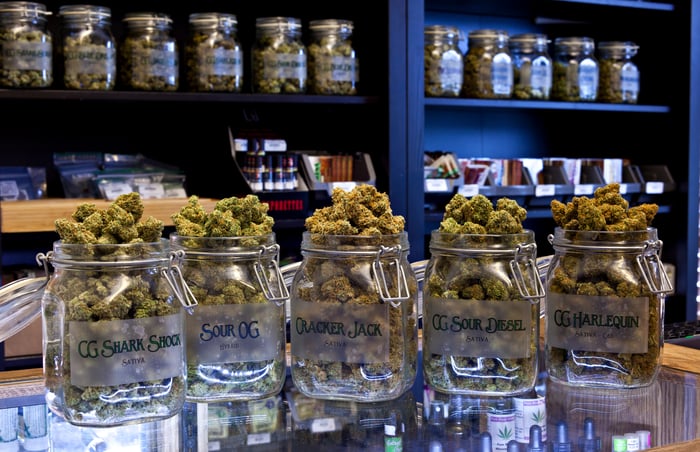For years, there wasn't a hotter investment opportunity on Wall Street than marijuana stocks. Until the end of the first quarter of 2019, you could have thrown a dart at a list of publicly traded pot stocks and likely come out a significant winner.
But all of that changed in April 2019. Over the past 15 months, cannabis skeptics have come out of the woodwork. In Canada, persistent supply issues have kept legal product out of licensed dispensaries, while high tax rates on legal weed in the U.S. have made it very difficult for licensed producers to compete with black-market cannabis. Add on the coronavirus disease 2019 (COVID-19) pandemic, and you have a recipe for disaster.
Yet, in spite of the record-breaking coronavirus crash during the first quarter, five pot stocks managed to end the first-half of the year (pardon the pun) in the green.

Image source: Getty Images.
Scotts Miracle-Gro: Up 27%
Although it's not a cannabis pure-play, Scotts Miracle-Gro (SMG 2.24%) gains inclusion to this list given the growing contribution to total sales from its cannabis-focused subsidiary Hawthorne Gardening.
Scotts Miracle-Gro is a company that most folks probably know best for their lawn and garden care products. Though traditionally a seasonal and weather-dependent segment, Scotts has seen a substantive uptick in lawn and garden product demand due to COVID-19. With people stuck at home, lawn and garden projects are there to keep them busy. Recently, Scotts upped its sales growth forecast for this segment for fiscal 2020 to between 9% and 11% from a previous growth forecast of 1% to 3%.
But make no mistake about it, Hawthorne is what's really driving Scotts Miracle-Gro's top and bottom line for the foreseeable future. Following the acquisition of Sunlight Supply in 2018, Hawthorne has a wide-range of hydroponic equipment, along with lighting, soil, and nutrient solutions it can supply to indoor cannabis growers. Hawthorne now comprises about 17% of Scotts' total sales, but is expected to grow revenue by 40% to 50% in fiscal 2020.
With Scotts Miracle-Gro's core business consistently profitable and Hawthorne growing like a weed (so many marijuana puns!), investors have liked what they've seen so far in 2020.

Image source: GW Pharmaceuticals.
GW Pharmaceuticals: Up 17%
Management may not want to be lumped in with traditional pot stocks, but cannabinoid-based drug developer GW Pharmaceuticals (GWPH) was blazing hot during the second quarter.
If you're looking for a reason behind the 17% move higher through the first half of 2020, look no further than lead drug Epidiolex. The cannabidiol (CBD)-based therapy approved by the U.S. Food and Drug Administration (FDA) to treat two rare types of childhood-onset epilepsy delivered $116.1 million in net product sales in the first quarter, which accounts for almost all of the $120.6 million in net sales reported by GW Pharmaceuticals. More important is the fact that net sales of Epidiolex blew Wall Street's estimates out of the water, with the company's net product sales tripling from the prior-year period.
Until recently, GW Pharmaceuticals was the only FDA-approved therapy for Dravet syndrome, giving it a clear path to market share in the indication. With competitor Zogenix running into a few speed bumps prior to its FDA approval of Fintepla for the treatment of Dravet syndrome, it's given GW Pharmaceuticals a potentially longer runway to secure physician and patient trust.

Image source: Getty Images.
Innovative Industrial Properties: Up 16%
Perhaps the only cannabis stock that truly seems unstoppable is real estate investment trust (REIT) Innovative Industrial Properties (IIPR 2.93%). Since operating a REIT is a low-cost model, save for the initial acquisition of properties, it's allowed IIP to quickly pad its profits in a fast-growing industry.
As of July 1, Innovative Industrial Properties owned 58 assets (cultivation facilities and processing sites) in 15 states. For reference, it owned 11 assets on Dec. 31, 2018, so it's been acquiring properties very aggressively in the U.S. over the past 18 months.
The great thing about this strategy is that it leads to highly predictable cash flow and the ability to generate modest organic growth. IIP leases its properties out for 10 to 20 years at a time, and passes along rent increases on a yearly basis. Also, a 1.5% management fee is applied, which is based on the annual rental rate. At last check, the weighed-average lease length on its 58 properties was over 16 years.
Innovative Industrial Properties is also benefiting from U.S. lawmakers failing to pass cannabis banking reform. With plenty of cash on hand via secondary offerings, IIP has become a regular provider of sale-leaseback agreements. With these deals, IIP acquires a property for cash from a U.S. cannabis company, then immediately leases it back to the seller for an extended period of time. As long as cannabis banking reform remains dead-on-arrival in the Senate, IIP will hold a key competitive advantage.

Image source: Getty Images.
Trulieve Cannabis: Up 6%
It should also come as no surprise that U.S. multistate operator (MSO) Trulieve Cannabis (TCNNF 2.10%) was one of the best pot stocks during the first half of 2020. I say "no surprise" because Trulieve is one of the most profitable marijuana stocks.
During the COVID-19-impacted first quarter, Trulieve brought in more than $96 million in sales and produced $49.4 million in adjusted earnings before interest, taxes, depreciation, and amortization (EBITDA). That's a 161% improvement in year-over-year EBITDA. With Wall Street tired of promises and wanting real results from cannabis stocks, Trulieve is one of the few companies that's been able to deliver.
The key to its success has been a laser focus on its home market of Florida. Recently, Trulieve opened up its 50th dispensary in the Sunshine State -- the company only has two operational retail stores outside of Florida. By keeping its focus on a single state, Trulieve has effectively built up its brand, gobbled up the lion's share of Florida's medical marijuana market, and kept its operating expenses reasonably low.
With the Sunshine State not expected to go after recreational legalization until 2022 -- which may require Trulieve to, again, establish its market share – the company's cash flow and market share remain safe for the foreseeable future.

Image source: Getty Images.
Green Thumb Industries: Up 3%
Last, but certainly not least, U.S. MSO Green Thumb Industries (GTBIF -1.18%) tacked on a 3% gain during the highly volatile first-half of the year. And yes, this means not a single Canadian cannabis stock was a top-performer during the first six months of 2020.
One thing working in Green Thumb's favor, other than the fact that it's operating in the most lucrative cannabis market in the world, is that it's not scrambling for funding like many of its peers. Green Thumb was able to secure a round of traditional financing in 2019, and has taken advantage of sale-leaseback arrangements with Innovative Industrial Properties to boost its cash balance.
Additionally, Green Thumb's outperformance is due to the quality of its revenue. Though dried cannabis flower is most often associated with the marijuana movement, derivative products are considerably more profitable for pot stocks. Derivatives are non-dried flower products, such as vapes, edibles, infused beverages, concentrates, and topicals. Roughly two-thirds of Green Thumb's sales are from these higher-margin products, which is a big reason the company looks to be very near recurring profitability.
Green Thumb's markets are playing a role, too. The company has pushed aggressively into Illinois, which opened its doors to adult-use weed sales on Jan. 1, 2020, and bought its way into the Nevada market. Given the Silver State's strong tourism, it's expected to lead the country in per-capita cannabis spending by mid-decade.





